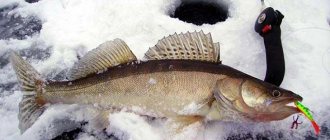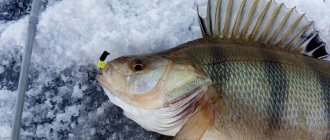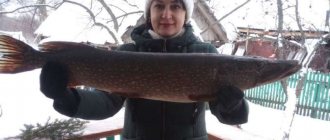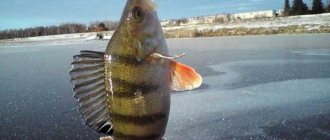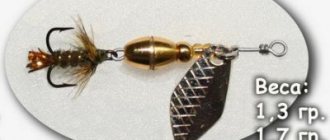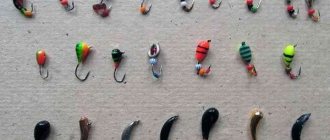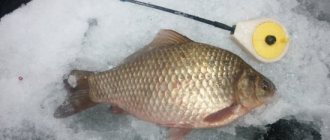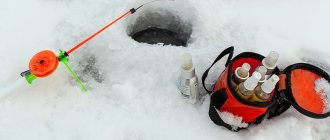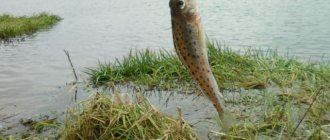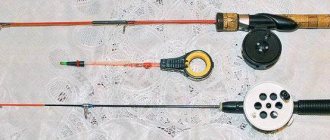Where to look for burbot in winter
After arriving at the reservoir, you have to decide where to look for burbot in winter. Finding a promising location is simplified on small rivers, in familiar areas of reservoirs and large rivers. If fishing is planned on an unfamiliar body of water, then you should conduct a reconnaissance of the condition of the bottom and its topography. A fishing echo sounder helps speed up the process of finding a place to catch burbot from the ice.
You should always be prepared to travel long distances. To store fishing accessories, it is convenient to use bags designed for bikepacking. Waterproof products that can withstand cold temperatures down to -30°C can be purchased here. They fit easily on a snowmobile or sled.
Signs of the possible presence of burbot:
- Sandy or rocky bottom;
- The presence of bottom snags, large stones or other obstacles behind which the predator sets up its ambushes;
- Entrances (exits) from pits;
- Depressions in the coastal zone. During periods of high activity, you can count on a bite at a depth of 1 m.
When choosing a promising place for fishing, you should take into account that burbot is not found in silted areas.
When searching for burbot, you need to focus on areas where it actively pecked in past seasons. The predator rarely changes its usual habitats.
Successful opening of the season and evening burbot. Weekly report from Kirov reservoirs
The past weekend in Kirov turned out to be mostly sunny, although quite frosty for this winter: the temperature ranged from -20 at night to -8 degrees during the day. The ice on reservoirs has become stronger, which fishermen are actively taking advantage of. Read what they managed to catch and who became the record holder of the week in our regular report.
Yulia Semakova spent Friday evening fishing in Vyatka, 200 km from the city. According to the girl, the temperature was about -24 degrees, but the “correct” clothes helped not to freeze on the river. She used dendrobena worms as bait - two per hook. In the end it was a good catch.
Ivan Blinov, on the contrary, fished in the morning, until 10 o’clock, on Letka. The total catch was 1,700 grams.
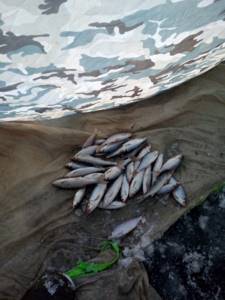
Vladimir and Anastasia Chekalkin got a good catch of perch. They were fishing in Vyatka Bay.
- In the first half of the day there is a spinner, in the second - a reelless one. Departure at 9:00 and 14:00.

Alexander Kropachev was fishing on the Kumenka River, and although his catch was not very large, he was overall pleased with the fishing:
- There is fish. The pressure is pressing. The snow crunches. And there is open water.
We caught everything. Those who are more experienced and know the places caught bigger and more. We had a good rest, the hole, however, tightens quickly. We fished with bloodworms and without bait. Oparik is ignored. The traction is good, the fish are in the pools.
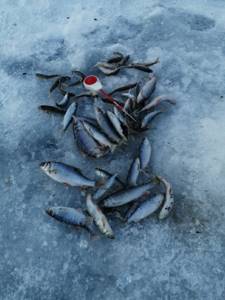
But Vladimir Shaklein managed to see only two bites during the whole day at the well-known “theater” - Petrovskaya oxbow.
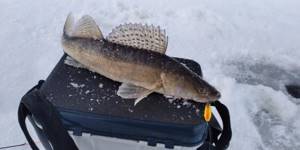
Mikhail Starikov also didn’t have a big catch on Kuprikha:
“There was quite a bit of bite in the morning, but the weather was good: frost and sun... We had a walk and got drunk. There are nine pieces of fish, enough for a cat.

Eduard Gundyrev was much luckier: he opened the hard water season with several pikes at once.
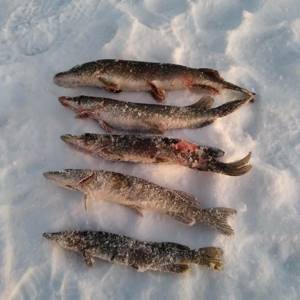
Pavel Serkov did not reveal the fishing spots, but he was not satisfied with the catch.
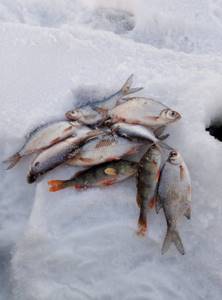
Alexander Zemtsov was also not satisfied with his catch, although overall it was pretty good, and the bite was “mad”:
- Petrovka, no nozzle. One little thing, no trophy today.
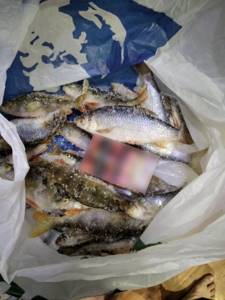
Evgeniy Shatkov still managed to catch some perches on the same Petrovka using a spoon.
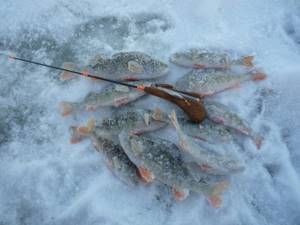
Evgeny Tebenkov also got some perches on the Makaryevskaya oxbow. He was fishing with no bait.
– There is a large perch in the camera, but it doesn’t want to bite.
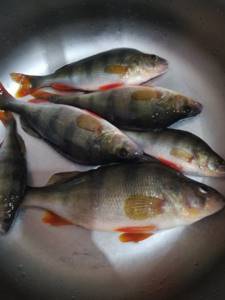
Dmitry Zemtsov also got a perch, but the size of the catch was much larger:
– Beluga, at two meters, on the balance beam. At 12 we left for home.
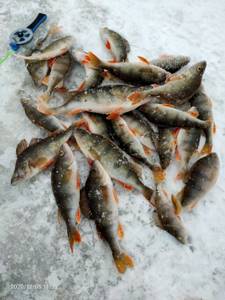
And the record holder of the week is Eduard Gundyrev - for the successful opening of the season with a predator.

Next weekend, according to weather forecasters, will be quite frosty, although sunny. Of course, fishermen are counting on a good bite for burbot, and also hope for perch and pike perch. Read our next report to see what catch they will be able to boast about.
Photo: vk.com/ribalka_v_kirove
On this topic
1925
“The north smells of diesel fuel and garlic.” Shift workers talk about why they are drawn to the North and how not to be deceived by employers’ promises
Behavior of burbot in winter
When conducting targeted fishing, you need to take into account the behavior of burbot in winter. It depends on weather conditions and burbot spawning.
Burbot in December
In December, the likelihood of catching a trophy specimen increases. This is due to the fact that sexually mature individuals actively feed in anticipation of spawning. The pre-spawning feeding period of burbot is long. It begins from the moment the water temperature drops from +5° and continues until the start of spawning. Usually this is the second half of December.
Burbot in December also depends on daily temperature. On sunny days, the predator becomes sedentary and attacks prey as soon as it comes into its field of vision. Activity increases at dusk and lasts until dawn. But throughout the night the intensity of the bite changes. After midnight, the bite may be periodic. Recovers in the pre-dawn hours. In cloudy weather, which is not uncommon in December, burbot can be successfully caught within 24 hours.
Burbot in January
In January, burbot spawning may end or continue. Depends on the climatic conditions of the region. Females spawn eggs at different times: large individuals are the first to spawn, followed by smaller burbots, so the duration of spawning increases. If a large population of this fish lives in a section of the river, then the beginning and end of spawning may not be noticed.
catching burbot video on the first ice photo
Good afternoon. Burbot is a highly revered fish among all fishing enthusiasts; it is respected and valued for its excellent taste and the absence of small bones, as in many other inhabitants of our reservoirs. And burbot fish soup is just a fairy tale, just like any other dish, and today we will talk to you about the topic of catching burbot, video on the first ice, photo. Burbot is the only fish from the cod order that is found in fresh water bodies on the continent; all other cod are sea or ocean inhabitants and they live in salt waters. Burbot is a cold-loving fish and with the onset of autumn and the arrival of cold weather, its activity increases sharply, and fishing for it only gains momentum on the first ice. Burbot is a distinct bottom-dwelling fish, and it is almost impossible to find it in the upper layers of water, except sometimes during the formation of the first ice, but more on that later. The hunting time for burbot on the first ice begins with the onset of dusk; it sits in its shelters all day, and at night it comes out to feed. Burbot patrols the immediate surroundings in search of dormant fish, and often it enters shallow water, approaches the boundaries of vegetation, and in general is everywhere where its food fish sleeps. The organs of smell and hearing are quite powerfully developed in burbot and thanks to these senses it detects its prey in complete darkness.

The hunt occurs as follows: having discovered a small fish, the burbot quietly approaches it and with a sharp movement of its mouth swallows the prey, not grabbing it, but sucking it inside. Among the food supply of burbot are not only small fish, including minnows, loaches, ruffs, bleak, small fish of any other fish in the reservoir, and often their smaller relatives. At the same time, burbot is capable of swallowing fish of a fairly large size, slightly less than half its size, the main thing is that it is oblong and elongated. In addition to fish, the burbot's diet includes various bottom inhabitants, small mollusks, leeches, small crayfish; it does not disdain fallen, even rotten fish and other animals, i.e. the diet is quite wide. The peak of burbot activity and excellent appetite occurs during the period of first ice. Among the methods of catching burbot on the first ice, two can be distinguished, the first is trolling, and the second is different bets, there can be girders, donks, undercuts, hook lines, in general there are all sorts of options here.

Flashing burbot on the first ice is an extremely interesting activity, but not always effective, firstly, this must be done at night, since burbot very rarely comes out to feed during the day, and secondly, it is quite difficult to guess the paths along which burbot goes hunting . But there are some interesting points: burbot are very attracted to various sounds on the bottom, and fishermen have come up with ways to produce these sounds. There are designs of double summer heavy vibrators of the same shape and size; they are hung on one winding ring and touch with their convex parts, so as not to get confused, the tee on one of them is removed. Next, the angler will lift this tackle from the bottom by 20-30 cm and throw it to the bottom, or simply shake it above the bottom, creating noise. Annoying sounds can force the burbot to attack the source of the noise, and the probability of being hooked is very high. In addition to rattles, various devices are also used that strike the bottom, tubular structures with rattling balls, the main thing here is to create noise at the bottom, which will cause an attack by the burbot. Many methods of catching burbot on the first ice using noise baits were described by Saboneev, for this reason we will not repeat them. Modern baits have essentially not changed since that time, only their shape has been slightly improved. The bottom spoons and various balancers that are familiar to us practically do not work; burbot can only be caught on these tackles by accident in the form of extremely rare exceptions.
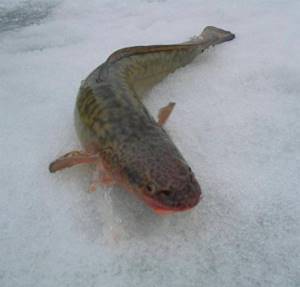
The most effective fishing for burbot on the first ice using various stakes, girders, lines, etc. The placement technique is no different from pike fishing, the only difference is the duration of action and the bait. Donks and girders are placed at night, and if there is pike or pike perch in the reservoir, then in the daytime it is possible to change the bait for these predators, and at night set up the gear for burbot. When fishing for burbot on the first ice, girders, unlike pike baits, should be installed so that the bait is at the very bottom or literally 3-5 cm from the bottom. The main line is only as long as the depth of the chosen place and is tightly tied at the top! If you make a free unwind like when fishing for pike, then there is a huge chance of saying goodbye to the gear and, accordingly, to the catch, since the burbot will invariably pull the hook and line under a snag, stone or other shelter and it is not a fact that you will be able to pull it out from there. Having caught its prey, the burbot stands still and swallows it, and only after swallowing it begins further movements. While a pike perch or pike, having grabbed the prey, immediately swims away a certain distance and only then swallows it, for this purpose, when catching them, they freely unwind the fishing line from the reel. Now it becomes clear why the burbot does not need to be given a free fishing line; it will already be caught in place, swallowing your bait. As bait, you can use any small fish from a local reservoir; gudgeon, ruffe, and char work great; you can use cuttings from almost any fish, even salted herring.
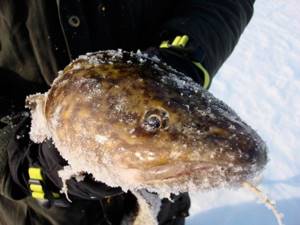
And, finally, I would like to talk about one interesting old-fashioned method of catching burbot on the first ice. When a body of water is covered with a layer of ice thick enough to hold a person, at night a couple of people go out onto the ice, one has a powerful lantern or a bright torch in his hands, and the second has a wooden mallet, something like a large mallet with a long handle or an ax like that. on an extended handle. The first days the ice is quite transparent and the snow cover has not yet established on it; all the snow is safely blown away from the surface by the wind. So, the first person with a flashlight shines on the ice, looking for a standing burbot under the ice. Sometimes it happens that on the first ice the burbot often stands right under the ice edge. I can’t say exactly why he does this, but there is a version that he had a fairly powerful dinner and rose to the colder layers of water, and this is precisely near the ice, so that the food would begin to be actively absorbed. You and I remember that fish are cold-loving and everything is not like normal fish, it’s the other way around, those need heat for normal digestion, but this one needs cold. So, hunters or fishermen, I don’t even know what would be more correct, carefully walking on the ice in soft shoes, most likely in felt boots, or on wide skis with fur or felt soles, it’s still safer on skis, and explore the water area of the reservoir. Having discovered a burbot standing under the ice, a man with a mallet carefully creeps up to it and sharply “grunts” along the ice above the fish’s head. The stunned burbot floats up with its belly up, the ice is immediately cut out around it, fortunately it is still thin and can be cut through with an ordinary ax, and the prey is removed from the water with a net. This interesting method of catching burbot was practiced before, and maybe even now a similar hunting method is used somewhere. Now let's watch the advice of experts in the video, where they will tell us their secrets and secrets of successful fishing. Watch video and photos of catching burbot on the first ice.
video
Catching burbot on the first ice. Ice video
Catching burbot on the first ice. Video
If you liked it, tell your friends:
Features of catching burbot from ice
It is not advisable to count on active burbot biting immediately after casting gear, and plan fishing for 5-6 hours. Although, when fishing conditions are favorable, there are exceptions. It is better to start fishing during daylight hours and continue until nightfall.
Having decided on a promising place for fishing, you need to take care of the heating point. The best option is a tent, in which all fishing equipment is conveniently located and has burners for heating food. When fishing with live bait in a tent, you can prepare holes and, while waiting for the burbot to bite, catch small fish.
You need to be prepared to continue fishing after dusk and at night. It is advisable to provide spare power sources for electric flashlights, and a supply of fuel for burners. The required number of holes is prepared before dark. It is more convenient to break the growing ice crust with an ice pick.
What to use to catch burbot in winter
Winter tackle for burbot
Fishing for burbot in winter is carried out with the following gear:
- Winter zherlitsa, donka or postavushka;
- Winter fishing rod with nod;
- Change. Applicable if there is no ban on this gear under local legislation regulating the fishing of biological resources in a particular region.
Baits and lures for burbot
A good bite of burbot in winter is observed on various baits of animal origin:
- Live bait is a small fish that “lives” with a predator in the same body of water;
- Dung red worms. They are placed on hooks in a bunch;
- Sliced fresh fish;
- Shrimps;
- Fresh chicken or beef liver.
Winter baits for burbot:
- Heavy jigs with bait;
- Snitches. Nozzle-free models and those with bait are used;
- Artificial lures or baits attached to a jig head;
- Fishing balancers;
- Rattlins;
- Oscillating spoons;
- Analogues of aquatic inhabitants made of edible rubber.
Burbot for winter fishing
Practice shows that the best bite of a predator is observed on live bait. Therefore, burbot can be successfully caught using a winter bait, bait or a simple donka. These permanently installed gear “work” the same way. Zherlitsa differs from a simple donka in the presence of a bite alarm, although in frosty weather it often does not work.
Rigging a winter girder (donki) for burbot
When installing gear, it is necessary to take into account an important condition: the equipment of a winter girder or a burbot stand must ensure that live bait is located in the bottom layer of water. Additionally, it is necessary to provide for the possibility of freezing of the fishing line in the hole. As an option, the equipment is fixed to a copper or aluminum wire, the length of which is 5-10 cm greater than the thickness of the ice. Instead of wire, you can use a wooden pole.
Features of behavior
This predator is the only representative of the cod family in our fresh water bodies. The remaining species are marine inhabitants. Over millions of years of evolution, burbot has adapted to life in rivers and lakes, and feels comfortable in fresh water.
Biological features
Burbot, like most cod, is an inhabitant of the north. And in our reservoirs this species spread from the north. This fish loves the cold, warm water simply kills it. At temperatures above 12°C, burbot becomes inactive, looks for cooler areas in the reservoir - underwater springs, sinkholes under the shore, and hides there. When the water temperature exceeds 25°, the predator simply dies. Therefore, the range of the slippery hunter is the cold rivers of the north, flowing into the Arctic Ocean, and estuarine bays. It is also found in lakes not connected to the sea, having settled there during the Ice Age. There is little of it in the warm southern rivers of our country, and rare cases of capture are rather an exception to the rule.

Burbot does not overwinter in our understanding of the word. On the contrary, peaks of activity occur in winter. Spawning occurs in winter, so the best time to hunt for it is the pre-spawning and post-spawning periods. In regions and reservoirs, spawning dates vary from mid-December to mid-February. It also depends on the weather conditions of a particular year. But the trend is the same: the heaviest hunger occurs at the beginning of winter and continues until spawning, during which, as is generally accepted, burbot does not feed. But scientists refute this claim - there are a number of studies that have found a lot of food in the stomachs of spawning burbot. After spawning, the bite resumes and continues until the onset of the warm season. You can catch largemouth even in the summer. This usually happens in cold years and cloudy weather.
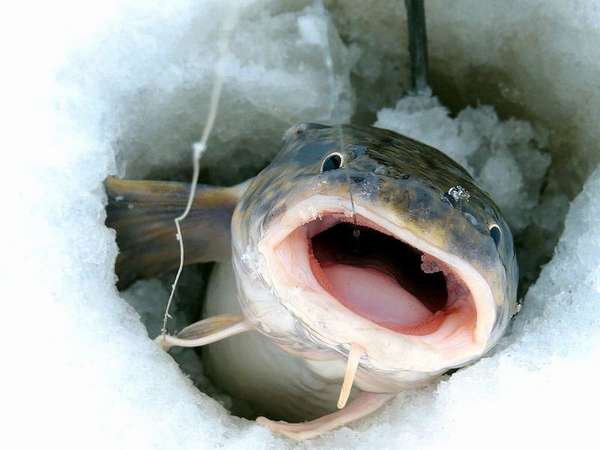
Habits
Burbot (in some regions also called “men”, “Khakas”) is a bottom-dwelling nocturnal predator. The period of activity and search for food begins at night. This fish is a strong individualist, and even if several individuals stand nearby, they still do not become a flock. The predators simply gathered in this place because the conditions were favorable for them. Burbot lives in the same suitable place for years (parking place), always going out to hunt along the same routes (paths), ranging from several tens to hundreds of meters. And in such a cluster huge numbers of fish can exist together. Often the parking lot is located near shallow water areas, where it is convenient for him to go out at night to feed. The largemouth passes along the trail once, visiting interesting places, after which it returns to the point where it continues to hunt until the morning. This feature is the main factor influencing fishing strategy.

In the reservoirs accessible for fishing in the middle zone and north-west, this predator leads a sedentary lifestyle. When it spawns in winter, it can go upstream of the river, swimming into shallow, clean channels and rivers suitable for spawning. The beginning of winter just coincides with the beginning of this movement, so catching burbot on the first ice can be extremely effective (if you find the path along which the fish migrates). After this, the fish returns to its previous location. This micromigration also occurs along paths, individually. Moreover, the fish actively feeds all the way, visiting schools of ruffs, roaches or other fish at night. The habits of burbot in winter are known and predictable, and the main thing for the fisherman is to find the right fishing spot. It makes no sense to try your luck chaotically throughout the entire reservoir. The purpose of the search is a specific parking area or trail.

In the northern latitudes, where the great Siberian rivers flow into the ocean, a semi-anadromous population of this fish lives. These individuals travel up to one and a half thousand kilometers upstream during spawning. By the way, the semi-anadromous population is the most numerous. It contains the largest specimens. And the closer to the south, the shorter the migration and the smaller the fish. The Ob-Yenisei basin, especially closer to the mouths of these rivers, is distinguished by the largest quantitative and qualitative presence of this species of fish, compared to other reservoirs. In these places the population reaches commercial importance. For ordinary fishermen, this Eldorado burbot is difficult to access - study the map in the Salekhard area and you will understand why.
Features of behavior
Burbot does not like light. More specifically, strong illumination. Therefore, he does not like bright sunny weather, preferring to hide in the shadows under stones. Small lights or a faint glow at night, on the contrary, sometimes attract a predator. It’s not for nothing that in the past, during burbot fishing, a fire was always lit at night. Experienced fishermen know in what weather this fish bites better in winter. And this is not a quiet night with high blood pressure. On the contrary, the best time is a northerly, gusty wind, a snowstorm, and atmospheric pressure surges. This feature turns fishing into a real challenge; you can’t do it without a tent.
Burbot has poor vision, and its main senses are hearing and smell. Having heard or smelled food, the predator slowly and gradually creeps up to the stimulus, and from a distance of 10-15 centimeters sharply grabs the prey. After which he often does not even move, but stands still, waiting for the victim in his mouth to become covered with mucus. Only after that he swallows it and moves on. Of course, if the concentration of large fish in a given place is high and there is great competition for food, then the predator will act more quickly.

Habitats and catches
Burbot is present almost everywhere in our country, except for the southernmost regions. You can catch burbot quite successfully in winter on the Volga, Kama, Oka and other tributaries. The further north you go, the more fish there are. Catching burbot in winter on Ladoga is already a completely common activity. In all the numerous streams, rivers and reservoirs of the Baltic basin, this fish lives everywhere. Of course, the anthropogenic factor negatively affects the population due to water pollution and artificial hydraulic structures, which make the existence of a semi-anadromous form almost impossible. But there are still a lot of these fish here. Fishing for burbot in winter in Karelia is as common as fishing for carp or crucian carp in the south. Many fishermen go out in December to catch burbot in the Leningrad region. They catch it in Bashkiria, and in the Urals, and in general throughout Russia to the Pacific Ocean.

If you move from Europe to the east, then the population size and the size of representatives increase up to the Ob, Yenisei and Lena, and then decrease again. Catching burbot in winter in Siberia is a common activity, often not even for the sake of a hobby, but for the purpose of obtaining food. And if you decide to devote your entire vacation to hunting this fish, then it’s better to go here for it. This is where you can count on the biggest trophy. In the Far East, this species is also found quite often.
Burbot on a winter fishing rod
There are no special requirements for a winter fishing rod for burbot. A classic fishing rod with a nod is used. The length of the rod is 30-40 cm. You can use a simple inertial reel or reel. The optimal thickness of the main line is 0.6-0.8 mm. A metal leash can be tied to the main fishing line. Durable types of fish hooks are suitable. It's better to use tees.
It is convenient to combine fishing with a winter fishing rod with fishing with girders. After “charging” the bottom gear, conduct active fishing with a fishing rod.
